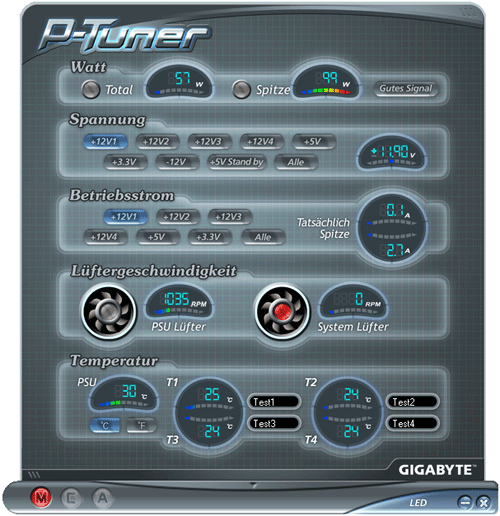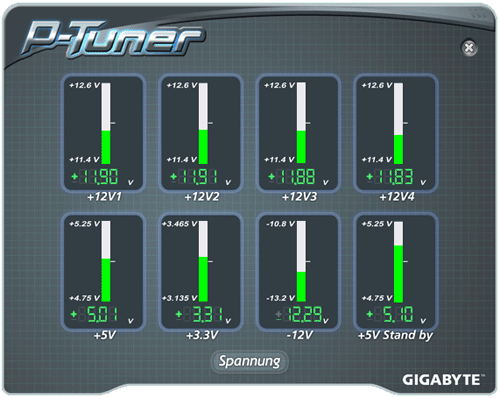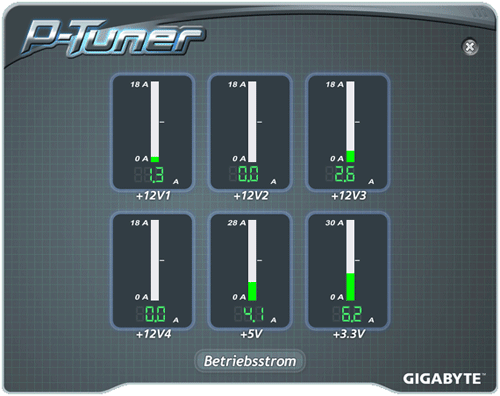Gigabyte's New Odin GT 800W Power Supply
by Christoph Katzer on July 24, 2007 12:01 AM EST- Posted in
- Cases/Cooling/PSUs
The P-Tuner Software
We have mentioned the software quite a few times already, so let's take a closer look. The P-Tuner software can be found on the CD. The installation is very easy but it does have one big flaw: it automatically detects the language of the operating system installed on the PC and uses that. You cannot change the language which unfortunately leaves us with the German version of the software since that is the language on our test PC. (Ed: Guten tag?) We might also point out that the translation used for some items is incorrect, and likely that is the same for other languages as well. Hopefully the language issue will be corrected with a patch in the near future, but for now you'll have to deal with German screenshots.

After a successful installation you will be greeted with this screen. This will only occur if the connection between the power supply and system is functioning correctly; if the connection is not established the software fails to start.
On the main-screen we have the actual usage of the system in watts on the left side and the highest amount used during that session on the right side. Compared to our results using the Chroma equipment, the amounts shown aren't identical. For example, with lower load testing we measured 160W from the rails and the software only showed 130W. If that amount had been correct we would have only had 68% efficiency, since the system was drawing 190W from the AC source. At higher loads the software showed 875W and in reality we were only drawing 771W - it's unfortunate that the software was incorrect, as we were about ready to start selling perpetual motion machines. In short, the results of the software are nothing close to reality, but it looks nice and it does at least give home users a place to start.

The second row shows the voltages of each rail. Each rail can be shown by clicking on it. If you want to see all rails at the same time you just click the All ("Alle") button on the lower right side of this row. A second screen will open and show all rails and their respective voltages. We compared the voltage on each rail with our equipment and found the results were quite similar. The differences were in the millivolt range and not more (i.e. less than .01V).

The third row shows the actual power drawn on each rail. By clicking on each rail the load can be seen in the little round display on the right side. The upper amount shows the actual used power on the chosen rail and the lower amount shows the highest power drawn on that rail during the current session. The amounts shown were not been equal to the actual loads we had put on the rails. We measured differences of up to 10A. Bringing up the details display, we can see all rails at once. The display shows on all 12V rails with a maximum 18A which is not quite accurate since two of the rails are rated at 25A.
We have mentioned the software quite a few times already, so let's take a closer look. The P-Tuner software can be found on the CD. The installation is very easy but it does have one big flaw: it automatically detects the language of the operating system installed on the PC and uses that. You cannot change the language which unfortunately leaves us with the German version of the software since that is the language on our test PC. (Ed: Guten tag?) We might also point out that the translation used for some items is incorrect, and likely that is the same for other languages as well. Hopefully the language issue will be corrected with a patch in the near future, but for now you'll have to deal with German screenshots.

After a successful installation you will be greeted with this screen. This will only occur if the connection between the power supply and system is functioning correctly; if the connection is not established the software fails to start.
On the main-screen we have the actual usage of the system in watts on the left side and the highest amount used during that session on the right side. Compared to our results using the Chroma equipment, the amounts shown aren't identical. For example, with lower load testing we measured 160W from the rails and the software only showed 130W. If that amount had been correct we would have only had 68% efficiency, since the system was drawing 190W from the AC source. At higher loads the software showed 875W and in reality we were only drawing 771W - it's unfortunate that the software was incorrect, as we were about ready to start selling perpetual motion machines. In short, the results of the software are nothing close to reality, but it looks nice and it does at least give home users a place to start.

The second row shows the voltages of each rail. Each rail can be shown by clicking on it. If you want to see all rails at the same time you just click the All ("Alle") button on the lower right side of this row. A second screen will open and show all rails and their respective voltages. We compared the voltage on each rail with our equipment and found the results were quite similar. The differences were in the millivolt range and not more (i.e. less than .01V).

The third row shows the actual power drawn on each rail. By clicking on each rail the load can be seen in the little round display on the right side. The upper amount shows the actual used power on the chosen rail and the lower amount shows the highest power drawn on that rail during the current session. The amounts shown were not been equal to the actual loads we had put on the rails. We measured differences of up to 10A. Bringing up the details display, we can see all rails at once. The display shows on all 12V rails with a maximum 18A which is not quite accurate since two of the rails are rated at 25A.










23 Comments
View All Comments
Gothik - Monday, January 7, 2008 - link
hi everyone,a noob here. I was wondering whether to get this PSU for my upcoming rig. I'm gonna run a quad core q6600, 4 sticks of ddr2 RAM, and a gf 8800GT (maybe SLI later). I was wondering, if the PSU is rated at 800w like the one being reviewed, does that mean that it is powered constantly at 800w or will the mechanism in the PSU determine the actual power consumed? Also, the author mentioned that there are a few PSUs that peform equally to this unit but cost less, can I know which ones are they?
Thanx.
QueBert - Monday, July 30, 2007 - link
about to buy a new PSU, want something future proof and modular. This looks about perfect for my needs. I find it odd that my Ultra X, which is years old and was the first Modular PSU. Still has better looking cables than any other modular unit on the market. Gigabyte seemed to step up the modular appearance a bit though. Kudos to them for that.wrong - Wednesday, July 25, 2007 - link
I can think of an excellent reason to honeycomb the side wall and put a sheet of plastic in to block airflow.Weight.
Not necessarily what they had in mind, of course. But LAN boxes should be light, and this could be one way to cut weight without reducing heatsink size and compromising cooling performance or noise.
I wonder if it makes a difference to EM noise.
Bozo Galora - Wednesday, July 25, 2007 - link
I really really like the way you do these PSU reviews. Much more informative indeed than anything else on the web. I am a bit dismayed over the way AT reviewers sugarcoat conclusions on obviously poor performing equipment - tho I understand why you have to do it.Now heres a review I would like to see......
There is a just out new Coolermaster MODULAR 1000W PSU with humungous rails
http://www.rbmods.com/Bilder/Articles/Coolermaster...">http://www.rbmods.com/Bilder/Articles/Coolermaster...
Heres the first review.......
http://www.rbmods.com/Articles/Coolermaster/Rs-a00...">http://www.rbmods.com/Articles/Coolermaster/Rs-a00...
This is the new esba model, NOT the current emba
Note in the review are the usual stupid useless graphs showing "rock solid" unchanging rails. Since I am about to buy, I would love to see how your review compares. And this is modular so it might help in your investigation of this modality.
Keep on truckin'
erikpurne - Tuesday, July 24, 2007 - link
Totally agree. It would be much easier to see where your system typically falls on the efficiency graph.
Also, on the 'Power Loss' graphs, the upper line should be input, and the lower one output. Oh, and watts are power, not energy!
Myrandex - Tuesday, July 24, 2007 - link
You should pictures of the LEDs, but there should have been a lights out LEDs enabled pic :)Good article though, and the build quality looked fantastic
the goat - Tuesday, July 24, 2007 - link
I assume that the software is only for windows? Of course the power supply will operate without the software but it would be nice to use the product to it's full potential with any operating system. In future articles please tell us if there is software for linux or not.Vidmar - Tuesday, July 24, 2007 - link
While I think the Efficiency charts in load percentage are nice, if you included Efficiency charts in watts it would be more informative from a buying perspective.The reason? I know the sum of system load is 375watts normally. The way it is now, if power supply XYZ has a max load of 650watts, I have to calculate where my ~375watts falls into that load chart (~57% load). But if the next power supply has 1000 watts max, then I have to yet again calculate what load percentage that may be for *that* power supply. If the Efficiency charts were in watts, instead of load, no calculations would be necessary. If I could look at your charts and see that XYZ power supply provided those watts the most efficiently, that would be the power supply I would get.
Maybe you could just provide a second X axis on the chart that included the watts.
Thanks!
MadBoris - Tuesday, July 24, 2007 - link
I really like the software component possibilities, looks like it needs some tweaking though like with 18a max per rail.As to memory and CPU usage, well that is .Net for you, that footprint problem is here to stay. Thx to MS.
I'm a little curious to the max 25a per rail.
Nvidia states 8800 GTX should have 30a http://nvidia.custhelp.com/cgi-bin/nvidia.cfg/php/...">Link
Maybe someone can clarify the real draw of an 8800 GTX and is 25a completely sufficient.
What about next gen?
Good review, looking forward to more like it.
As cool as this PSU is, $200+ is a bit too much for a PSU.
Christoph Katzer - Tuesday, July 24, 2007 - link
Depends on how much your graphics card needs to work. When your display just has 1024pxl in width you can run the 8800 in a decent system with a 300w psu. If you are using a 30" screen with 2560pxl in width it is a total different story. But don't worry, we are working on an article to make things like that very clear.